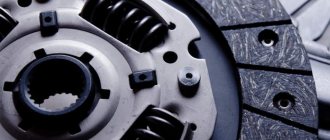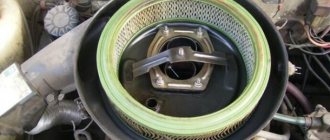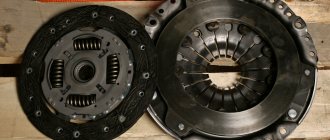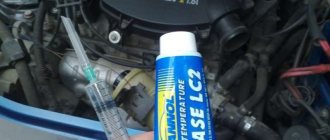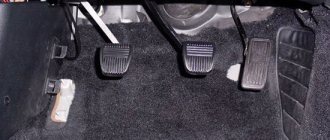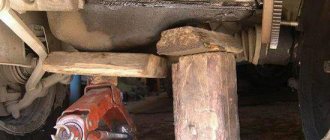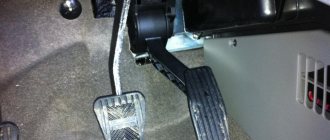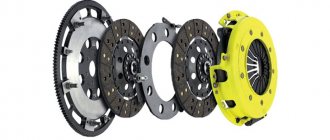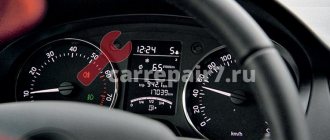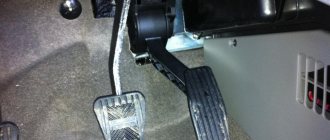Design and adjustment of the VAZ 2109 clutch
VAZ 2109 is the legendary “nine”. The front-wheel drive five-door hatchback was serially produced at the Volzhsky Automobile Plant from 1987 to 2004. From 2004 to the end of 2011, the VAZ 21093 modification was assembled in Zaporozhye.
Many car owners try to maintain their personal car themselves and know how to do it correctly, since they carefully study the operation of the main components and leading modules. The list of routine maintenance includes periodic adjustment of the VAZ 2109 clutch. This task is quite simple if you familiarize yourself with the operation algorithm in advance.
Return
Nine clutch device
The clutch kit is one of the key components of the Nine transmission. This is a single-disc friction-type mechanism located between the engine and the gearbox (gearbox). The algorithm for its operation is as follows:
- Initially, the car is stationary, the engine is started, the pedal is released. The gearshift lever is in the neutral position, that is, the rotation of the input shaft is not transmitted to the secondary shaft.
- The driver is preparing to move forward. With his left foot he presses the pedal, and the mechanism disconnects the gearbox input shaft from the engine. The driver moves the lever to the first gear position, the mechanism ensures the engagement of the primary and secondary shafts of the gearbox. The car is stationary because the engine is disconnected from the transmission input shaft.
- The driver smoothly but decisively releases the pedal. The engine is connected to the input shaft, the task of which is to transmit power to the drive wheels through the secondary shaft, then the car will start moving.
- Switching from first gear to second, from second to third, and so on occurs in the same way.
The VAZ 2109 clutch design is such that when the pedal is released, the driven disk is clamped by springs between the flywheel and the pressure plate. In this case, power is transferred to both gearbox shafts and the drive wheels.
When you press the pedal, the VAZ 2109 clutch fork rotates through a special rod and presses on the levers that retract the pressure plate. The VAZ 2109 clutch driven disc is disconnected and power transmission stops. The mechanism casing is connected to the pressure plate by three pairs of elastic plates.
The unit is driven by a cable, its lower tip is fixed with nuts in a bracket on the engine crankcase.
The clutch cable is connected to the clutch release fork lever.
Return
Typical VAZ 2109 clutch malfunctions
The clutch is one of the relatively reliable units of the VAZ 2109. With normal operation and periodic adjustment, it lasts for years. The estimated resource of the unit exceeds 100 thousand km. And if the clutch pedal fails, this is a rare case. The list of typical faults includes:
| Type of problem. | What is expressed? | What is the reason. |
| The clutch drives. | Pressing the pedal all the way does not ensure complete disconnection of the shaft from the gearbox, and the engine is not disconnected from the gearbox. Pressing the pedal when the unit is faulty leads to the fact that the pressure bearing does not act strongly enough on the damper spring, and the engine flywheel continues to partially transmit torque to the gearbox shaft. | The reason for this is often poor adjustment of the VAZ 2109 clutch cable or failure of the drive disk. |
| The clutch is slipping. | When the pedal is fully released, the gearbox input shaft remains loosely pressed against the engine flywheel and slips, that is, slippage occurs. The torque is only partially transmitted to the drive wheels and sliding of the contact surfaces occurs. This effect is clearly manifested when a loaded car is moving uphill: the driver accelerates, the speed increases, but the car almost does not accelerate, the clutch of the VAZ 2109 slips. | In this case, the drive is most often poorly adjusted, the clutch cable gets stuck, the driven disc is worn out or oily, which is why the clutch slips. |
| Noise when switching off transmission. | When you press the pedal, a distinct rustling or rustling sound is heard. | This quiet sound may indicate a possible release bearing failure. Continuing to operate the car in this condition can lead to troubles: if it jams, the VAZ 2109 clutch basket will inevitably quickly fail. Change the bearing at the first sign of a malfunction, otherwise serious repairs to the clutch, including replacement of the basket, are inevitable. |
Clutch adjustment is not only included in the list of routine maintenance of the VAZ 2109, but is often a way to eliminate emerging malfunctions of this mechanism.
Return
Eliminating the creaking of the clutch pedal on a VAZ 2110. — logbook of the 2003 Lada 2110 PhiX on DRIVE2
Hi all!
We continue to mock the car, and this time we will make the clutch pedal softer and quieter. I think many owners of tens and other front-wheel drive VAZs have noticed that the clutch pedal becomes tighter over time and a squeak appears. There may be several reasons for this, and I want to talk about the fight against one of them. In search of the cause of the tight pedal and creaking, I took the easy way and first tried to lubricate the cable and boss, which naturally did not bring any effect. Having eliminated the cable, I moved on. The reason for the tight pedal and squeaking is the friction that occurs between the bushings and the axis of the clutch release fork. This happens because over time the lubricant loses its properties. The main source of the problem is the lower bushing, because it is metal, and as you know, metal slides without lubrication with great reluctance, with the risk of scuffing, i.e. with excess friction. The upper bushing is plastic and even without lubrication the axle glides well in it.
This is what these bushings look like.
Thus, the main task is to lubricate the lower bushing. Ideally, you would have to remove the box, replace both bushings with new ones and fill them with fresh grease. But since we have enough more important things to do, throwing away the box in vain was not part of my plans. I decided to implement an improvement that I learned about a long time ago, but as always, I never got around to it.
The essence of the modification is to drill a hole in the plastic bushing of the clutch fork axis, and then lubricate both bushings through this hole.
It all sounds very simple, and in reality the same thing happens. Next in order: We remove the air filter box so that it does not interfere.
We find this very bushing. And it is located at the checkpoint, strictly under the thermostat.
We drill a hole in it with a diameter of about three millimeters so that the nose of the syringe can fit through. By the way, in order to reach the bushing, you will need a fairly long drill. You can probably try to drill a short one, but the wiring harness and CO pipes will get in the way. You need to drill until the drill rests on the fork axis.
Then we fill the syringe with oil, I used transmission oil, and slowly pour it into the hole. The oil will not go away quickly, because... The bushing fits tightly to the axle.
To speed up the process, you can slightly lift the bushing (as far as the latches will allow) by prying it around the perimeter with a screwdriver.
You need quite a lot of oil so that it flows along the axis and properly lubricates the lower bushing. I poured about thirty cubes, there is no need to be afraid of overdoing it, the excess will simply flow out.
You can plug the hole using a screw.
If you suddenly need to lubricate the bushings again, this can be done by simply unscrewing the screw.
After the procedure has been completed, we get behind the wheel, squeeze the clutch and almost have time to get upset, because nothing has changed. But We don’t give up, we press the clutch five or ten times again, and on the next press the pedal falls down with less effort and without the nasty squeak.
Conclusions: After lubrication, I finally got rid of the annoying squeaking noise and the clutch pedal became much softer. The feeling can be compared to replacing the clutch with a new one.
PEACE to everyone, like, share the post with friends, this is another modification for the VAZ from the MUST HAVE category!
Price: 50 ₽ Mileage: 179,800 km
Changing the release bearing
More information on how to remove and dismantle the bearing device from the coupling:
- Remove the gearbox. This will provide free access to all components and elements of the transmission and clutch system.
- Disengage the spring fastening from the coupling. To do this, use a screwdriver or other available tool.
- Dismantle the failed release bearing from the guide bushing. To do this, you will need to press out the 4 latches of the spring fastening and remove it. After removing the device from the coupling, carefully inspect the device for any defects or malfunctions. Make sure that the part has failed and needs to be replaced.
- Before changing and installing a new bearing, it must be checked. Delays during rotation of the device are not allowed, as are gaps. If the part is operational, then replace the coupling. When installing, make sure that the inner protruding part of the ring is directed to the side. After installation, the element must be secured with a fastener.
- Lubricant is applied to the guide, after which the bearing device is installed. The part is secured using a holder.
- The removed gearbox is installed and the functionality of the device is checked.
Removing the gearbox
The procedure for dismantling the gearbox can be performed differently depending on the design features of the machine. Removal of the unit should be carried out with an assistant. Before dismantling, the vehicle battery is disconnected and removed, as well as the transmission fluid is drained.
How to remove the gearbox:
Disconnect the clutch pedal cable. Remove it from the bracket. Disconnect the block with wires from the speed sensor installed on the box. Be careful not to damage the connector. To turn it off, press the latches. Using a wrench, unscrew the bolts that secure the ignition module bracket to the gearbox. Also unscrew the screws securing the transmission to the power unit. You will see connectors on the bottom of the gearbox; they need to be disconnected. Remove all screws that secure the torque rod bracket to the transmission housing. It is necessary to loosen the clamp of the rod clamp, which is designed to change gears. Disconnect this element from the hinge. Dismantle the wheel drives. Remove another nut that secures the transmission to the engine. Unscrew the three screws and remove the gearbox housing cover. It remains to unscrew one more bolt that secures the unit to the engine. Under the bottom of the car, find the nuts that secure the left and rear engine support of the car.
After this, the gearbox must be carefully moved along the guides. Dismantling the gearbox is carried out with the help of a partner
Replace the release bearing and reinstall the gearbox. Fill with new oil.
Drive and its adjustment
The clutch pedal on the viburnum has failed.
To begin with, if the reasons are still in the cable and it needs to be changed, dismantle the old part. It is attached directly to the gearbox with a bracket. Here you also need to unscrew all the bolts and nuts slowly and evenly. Next, the fork is disengaged after the cable has been slightly loosened, but not completely removed.
The cable itself needs to be looked for under the hood of the vacuum hydraulic booster of the brake system. Use a screwdriver or other similar element to pry up and remove the locking bracket, and only then dismantle the part. Sometimes the reason is not in the cable, but in the bushing to which it is attached. It may be bent or out of order, making it difficult to secure even a new cable correctly. Therefore, if a breakdown occurs, then this part is also replaced. It is also advisable to lubricate the new cable with a special compound to prevent damage from friction.
This part requires regulation if installed in a VAZ-2110. It's easy to check everything. Take a ruler and measure the distance from the floor to the pedal strictly perpendicularly. If it is more than 16 centimeters, then all excess on the cable is cut off. When the new element is installed in the reverse order, you need to get behind the wheel and try the precision of the pedal.
Even though it's already passed, it might be useful to someone. Such garbage: The day before yesterday the clutch pedal failed and does not go back, the cable is normal, the clutch drive pulled (the 9th clutch release fork in the figure https://automan.by.ru/vaz/010/scepl.shtml) on the box itself, it (the fork) dangles quietly back and forth, it feels like it’s not catching on anything inside the box. The clutch sank literally in 3-4 clutch presses, before that the car didn’t slip or jerk, so it doesn’t look like a basket. There was a suspicion that the welding fork (3 in the figure) had moved away and was turning along the shaft.
It was repaired yesterday and it came out to 1210 (1000 - work and 210 - fork), it did not break exactly as I thought at first. Rod 1 on line 4 burst. By the way, the fork (both new and old) was welded far from what is shown in the figure. It is literally stuck there by about 1/3 of the radius, if not less, and the new fork also had to be adjusted with a hammer (it did not sit in place). They can’t weld two pieces of iron properly and they’re wasting so much money. OtechAvtoprom e3.14t, “uki.
14 years on the forum
From: Moscow. VAO.
Car: Honda Accord 2.4 exe + Opel Corsa 1.4 cosmo + VAZ 21103 plucked but undefeated
Mine fell off exactly the same way. I completely agree - the design is simply bestial. _________________ Everything that does not kill us makes us stronger.
All exactly the same as mine! The plug burst at 51 thousand mileage, in the same place as the author of the topic. The craftsmen said that these are not only forks, but also 2112 baskets are very bad, the leaves are tight, which is why the forks burst. In front of me they removed the disc, basket and release lever. The rivets on the disk are already in use, the release mechanism has some play. In short, I changed everything at once to German KRAFT. The clutch became like in a foreign car, soft and takes smoothly. The car slips only when the clutch pedal is completely released! BLISS
It broke down in exactly the same place for 42 thousand. At least once I could sue this fucking AVTOTAZ for money. I bought a new car, I really like to take care of the equipment, the car has been in perfect condition for three years, during this time I haven’t changed much, I just like the equipment to be in perfect condition, I still have a little bit to save up, I’ll take a Mercedes E240-E280 2000. restyled, I think it will cost 650-750 thousand. AVTOTAZ will not lure me into its network. I’m waiting for our Miracle State of RUSSIA to finally join the single economic space, there will be no duties on foreign cars and finally AVTOTAZ will suck forever. TAZ-21102 2002 48000 tk.
AVTOVAZ may suck, but only in conjunction with all of Russia, i.e. and you'll get in line.
13 years on the forum
From: Tolyatti, Zhigulevsk
AVTOVAZ may suck, but only in conjunction with all of Russia, i.e. and you'll get in line.
so they are already up and the queue is already being served. Housing and communal services and kerosene have become more expensive - everyone is silent. But this is one of the conditions for joining the WTO (it sucks) to bring domestic energy prices to the same level in accordance with world prices. about nini salaries.
Signs indicating the need to adjust the clutch on a Lada Kalina
Among obvious symptoms such as: problems with gear shifting, extraneous sounds when depressing the clutch pedal, poor traction and the clutch not completely disengaging, there are other signs that indicate the need to adjust the Lada Kalina clutch. In order to identify them, carry out a simple check.
The engine must be completely stopped. Depress the clutch pedal several times and listen for any extraneous sounds while pressing, for example, friction, squeaking, clicking, etc.
d. Pay attention to whether there is any jamming while moving the pedal. If you cannot feel it with your foot, try pressing the pedal with your hand and check the stroke. If the pedal jerks or sticks while driving, the clutch most likely needs to be adjusted.
Other signs of the need to adjust the clutch of your Lada Kalina:
- Take a ruler and check the distance from the floor of the car to the outside of the pedal.
- Depress the pedal fully until it hits the floor.
- Release it and check the distance again; if it exceeds 14.6 cm, it is necessary to adjust the pedal travel.
- If: the full pedal stroke is 14.6 cm, the lower cable guide moves freely relative to the release fork lever by more than 2.7 cm, there is a runout of the driven disk linings of more than 0.5 mm, and the distance between the linings and rivets is less than 0, 2 mm - adjustment or complete replacement of the clutch is necessary.
What to pay attention to
There are certain signs that the clutch on the Lada Grant has failed and action needs to be taken. It is worth paying attention that if the car has just been purchased, the pedal will be pressed quite easily. If this requires great effort, then this is the first evidence that the clutch needs to be adjusted or replaced.
It is also worth paying attention to the appearance of extraneous squeaks at the moment when the driver presses the pedal. In addition, it should not twitch when the car owner does not touch it.
Most often, car enthusiasts are faced with the fact that the pedal travel becomes too tight. It is worth considering in more detail the reasons for this problem.
Causes of slipping and ways to eliminate them
Not in all cases you will necessarily have to buy a completely new clutch. Once, out of inexperience, I changed a unit, which turned out to be almost completely serviceable. In reality, it was just necessary to change one inexpensive component. But sometimes you have to learn from your mistakes.
From everything I have learned, I realized that determining the cause of clutch slipping plays a key role here. Your further actions directly depend on this.
- The clutches are worn out. Your actions depend on the degree of wear. When the distance between the working elements used is less than 0.2 mm, you can simply adjust the free play of the pedal. In case of severe wear, the driven disk and linings are replaced;
- Oil appeared on the linings. Oil on the friction linings may appear due to certain problems in the flywheel drainage or an excessive amount of lubricant in the box. The oil should be removed and the surface dried. Kerosene works well. After cleaning, go through with fine sandpaper;
- Damage to the integrity of the rubber components of the hydraulic drive. When they swell, the clutch very often begins to slip. Here you will have to remove both cylinders (worker and main), wash them with alcohol, replace the rubber elements and clean the expansion holes. Don't forget to bleed the clutch and the brakes themselves;
- Loss of elasticity of pressure springs. This problem occurs on old cars that have been in use for over 10 years. Elasticity decreases gradually, which causes the required level of pressure on the driven disk to drop. As a result, the clutch slips. The check is carried out by removing the clutch disc. If elasticity has decreased, they will have to be replaced.
There are cases when changing individual components or trying to restore their functionality is pointless. The wear or damage is so severe that repairs will only have a short-term effect. A better solution here would be to completely replace the clutch.
Subscribe, tell your friends about us and don’t forget to come to us again!
Watch this video on YouTube
Bleeding the clutch
When bleeding the clutch system, it is necessary to control the pedal. When inflated and the outlet fitting is open, it is necessary that it drops to the floor when pressing on it. It is better to perform these manipulations with a partner. When it collapses under the pressure of the assistant’s foot, a characteristic noise of gurgling air bubbles is created. This procedure must be repeated several times.
With a fully functional clutch system, the pedal returns every time it is released, but if it fails again, it means that something is wrong and it is necessary to re-diagnosis and repair.
Everything you wanted to know about the Ford Fusion but didn't know where to ask
- Unanswered topics
- Active topics
- Search
- our team
- FAQ
- Rules
- Fusion FAQ
- Articles
- Photo Gallery
- Search
- About
- User Guide
- CD6000 Guide
- Self Diagnostic
- DTC View
- Documents & Files
But what can we do?
Everything is very simple. For example, you arrived at an intersection where the traffic light was red. If the green light does not light up within 5-10 seconds, feel free to turn on neutral, and keep the car (if it is a slope) on the handbrake or brake pedal. Fortunately, many traffic lights have a timer, so you can predict the situation in advance. But this rule must be used not only at intersections, but also in any other traffic situation (for example, while standing in a traffic jam). You should not “play” with the clutch, sneaking behind an oncoming car in order to maintain a minimum distance.
The less time you keep the pedal depressed, the better for the bearing. Don’t be too lazy to once again move the gearbox selector to “neutral” - this way you can avoid, albeit not expensive, but quite time-consuming repairs. Since replacing the bearing involves removing the transmission and clutch basket. And if it is a rear-wheel drive car, then there is also a driveshaft.
How to get to a car service center if the pedal fails
When it turns out that the detected breakdown cannot be repaired on the spot, you will have to think about how to take the car to a service station or garage. If it happens during rush hour, it is safer to call a tow truck or have someone tow you. On busy roads or at night, you can get there on your own. How to do it? We tell you:
- the car is set to first speed;
- starts;
- then press the gas a little and the VAZ will slowly move off.
Be sure to turn on your hazard lights. It is also useful to think through the route in advance - it is important to constantly move along the main road, avoid traffic lights, crossings and any stops. When you can’t do without the latter, turn off the engine completely.
- dangerous to maneuver;
- change gears.
All this will lead to a breakdown of the gearbox, the repair of which costs much more than fixing a clutch malfunction or calling a tow truck.
Purpose
To understand where the release bearing is located, you need to understand the purpose and design of the clutch. The clutch and all its parts belong to the vehicle's transmission. It ensures the transmission of torque from the engine to the drive axle and wheels, and must be located between these parts of the machine
But an important condition for the location is accessibility in its control by the driver. Most often this is the clutch pedal, less often the lever near the steering wheel
Using the clutch mechanism, the driver periodically disconnects the engine from the transmission. This allows you to stop the car, change the gearbox, and change the driving dynamics.
Clutch failure
The pedal may also fail because the clutch mechanism has failed. It is this reason that you should think about when it turns out that the hydraulic system is working as it should.
Here you need to find out which part is damaged. There are several options, but most often the problem is caused by a sticking axle on which the release fork is installed. In addition, the foot element sometimes fails when worn out:
- diaphragm spring on the drive disk;
- release bearing located in the clutch.
To carry out diagnostics, you will have to disassemble the clutch. All damaged elements are replaced with new ones, which is impossible to do in the field.
Reasoning about alternative regulation
Before adjusting the clutch on a VAZ 2110 in the traditional way, let’s think about how justified it is, and whether there is any point in using an alternative option. According to reviews from many owners of “ten” cars, and not only them, the clutch control pedal is quite high from the floor. The inconvenience that most drivers get used to is actually quite significant.
The driver gets tired during the trip, he wants to change gears less and less, each time lifting a heavy boot. This affects not only the speed of movement, but also the condition of the transmission. Experienced drivers assure: when the clutch pedal is released, it should be positioned so that it can be depressed without lifting the heel from the floor. It’s not without reason that on UAZs and Gazelles, where adjustment is impossible, experienced drivers place a piece of board under the mat.
The classic adjustment order indicates data that ensures the clutch disengages with a large margin. As a result, by fully depressing the pedal, the driver forces the bearing to bend the diaphragm spring much more than is technically necessary. As a result, it loses its characteristic properties, and at critical moments it simply breaks
And it doesn’t matter that you chose a branded clutch kit to replace - everything is subject to the laws of physics
Method for alternative clutch drive tuning
Experienced car enthusiasts prefer to make adjustments individually for each set of coupling parts. The event does not require an assistant or special equipment:
- Start the engine, depress the clutch and engage reverse gear. On almost all VAZ models it does not have a synchronizer, so the disks are completely disconnected.
- Slowly release the pedal and simultaneously engage and disengage reverse gear.
- The moment the speed is switched on is manifested by vibration on the shift knob. If the setting was made according to the official factory instructions, then the start of activation will correspond to a distance of the pedal from the floor of 75-100 mm.
- Set the cable length so that the “grasping” moment corresponds to 20 mm from the floor to the top edge of the pedal.
After we adjusted the clutch on a VAZ 2110 in this way, the clutch pedal in the initial position is much lower than the brake pedal. This allows you to instantly switch the toe of the boot without raising your foot to the handlebars. Early activation greatly simplifies the process of driving a car; gears are engaged smoothly and without jerking.
The clutch pedal creaks on a VAZ-2110
Car: VAZ-2110. Asked by: Dmitry Aksenov. The essence of the question: the clutch pedal on the VAZ-2110 began to creak, what should I do?
Damn, bad again! The clutch pedal on the VAZ-2110 began to creak. At first it creaked quietly, but now it’s getting stronger. I looked there in the pedal assembly, tried to lubricate it, but I can’t find where. What to do if the pedal squeaks more and more?
Why does the clutch pedal on a VAZ-2110 squeak?
Experts note that the clutch pedal on the VAZ-2110 is not tight compared to other domestic cars. This is even noticeable when the lubricant on the rubbing parts of the squeezing force transmission dries out.
The following two tabs change content below.
All my life I have been surrounded by cars! First, in the village, already in the first grade, I was rushing around on a tractor through the fields, then there was JAVA, then a penny. Now I am a third-year student at the Polytechnic Faculty of Automotive Engineering. I work part-time as a car mechanic and help repair cars for all my friends.
Causes
In the diagram, red arrows indicate places where squeaking may occur due to lack of lubrication.
When you drive a car for a long time and do not have it inspected, this will cause the driver to feel discomfort when driving, for example, a creaking sound when pressing the clutch pedal.
- Typically, modification and elimination of such a problem is carried out by drilling a larger diameter hole on the shaft attaching the pedal to the body bracket. You can do this yourself.
- Before work, it is important to find a shaft of suitable diameter that will be placed in the socket.
- After installing the new shaft, you will need to drip 4-6 drops of oil onto it every day until it breaks in.
Other possible sources of squeaking
The “grandmother” on the bushing may creak.
The clutch cable holder can also be a source of squeaking noise.
Pin for fastening the clutch cable to the pedal.
Lubricating the brake pedal mounting pin.
Lubricate the clutch fork shaft through the side hole.
Lubricating the clutch fork axle through the hole in the plug.
Clutch release bearing: principle of operation, symptoms of malfunction and testing
Today, the most common clutch systems have two discs - a leading one, rigidly coupled to the crankshaft, and a driven one, transmitting torque to the gearbox.
To change gears or put the car into idle speed, the clutch discs must be disconnected, which is done using a release bearing that pulls the driven disc away from the drive disc.
Release bearing location
This is an important element of the clutch system, and at the same time one of the most vulnerable parts.
The clutch release bearing is at rest while the vehicle is moving, and only comes into operation when changing gears.
The part costs from 300 to 1500 or more rubles, depending on the manufacturer and model of the car.
Replacing a bearing at a service station will cost 3,000-7,000 rubles, so if you have the desire, opportunity and a normal set of auto tools, it makes sense to do it yourself and save a lot of money.
Types of release bearings
There are two common types of release bearings now:
- roller or ball - mechanical units that transmit force to the bearing through a rigid bunch of rods;
- hydraulic - here the force is created by hydraulics, due to which the clutch pedal is depressed much easier.
Hydraulic release bearing
Roller release bearing
The mechanical clutch release bearing can be called a part from the past, because Moskvich, VAZ and other old cars were equipped with it. New machines, even budget ones, mainly use hydraulic systems. Although a number of domestic cars currently produced are still equipped with mechanics, in order to reduce the cost and simplify them.
Operating principle
The release bearing's job is to connect and disengage the clutch when you press the pedal inside the car. The operating principle of the part is quite simple:
- the driven disk is pressed against the flywheel by a pressure disk, due to which clutch is ensured;
- the pressure on the pressure plate is provided by a diaphragm spring, the inner petals of which are acted upon by the clutch release bearing;
- the movement of the bearing, which initiates the separation of the discs, is ensured by the clutch fork.
Release bearing in a car clutch system
Causes and symptoms of release bearing failure
The reason for the breakdown of this part is uneven loads on it at the moment when the clutch is depressed, and it goes back along with the driven disk.
For this reason, holding the clutch pedal for a long time while the gear is engaged is strictly not recommended.
In principle, this is a reliable and durable part, and it most often fails among novice motorists.
The most important symptom of bearing wear is the appearance of a slight knocking sound when the clutch pedal is depressed.
If the sound appeared in the summer, this is almost a guarantee of future problems, but if it came along with frost, there may be an elementary change in the linear dimensions of the bearing cup due to a drop in temperature outside. The release bearing in most cars has an undeniable advantage - high strength, so even if noise appears, you can afford to do nothing for a while and watch to see if it gets worse.
How to check a release bearing
The clutch release bearing is checked by ear when the pedal is depressed while it is in operation (rotating).
Depending on the stage and nature of wear (a small amount of lubrication or depletion has begun), the sound will be different; it can either simply hum or make noise or make other unpleasant sounds in the area of the box.
But you should not confuse these sounds with those that can occur when the clutch pedal is not even depressed, since such a sign will indicate the input shaft bearing.
Why is the clutch on the VAZ 2110 tight?
here someone in my review wrote that after replacing the entire clutch, the pedal becomes weightless, apparently very light, but mine is very tight right now, so I was thinking of changing it, maybe something is faulty or has already worn out? Tell me what can affect the tightness of the clutch release? What might not be working correctly?
pws-nsk.ru Products for Martial Arts and Crossfit, tel.: 2-123-123
maybe change the fluid? what else besides e-liquid maybe, I was recently on a hundred, about a month ago, with the device they looked at all the liquids for replacement, everything was within the normal range, i.e. replacement is not coming soon they said
pws-nsk.ru Products for Martial Arts and Crossfit, tel.: 2-123-123
When all the components of the clutch are new - the petals of the basket are even, the basket is easy to push through. As the disc/basket/flywheel wears out, the basket becomes more humpbacked and it becomes more and more difficult to “break” it
Last edited by igor vm; 01/13/2012 at 20:55.
Professional repair of Subaru electric racks
What is the correct name for the return spring or what? does she have anything to do with it?
pws-nsk.ru Products for Martial Arts and Crossfit, tel.: 2-123-123
Message from 8eTeR
What is the correct name for the return spring or what? does she have anything to do with it?
Which is on the fork in the gallery - you can pull it into a string with your foot and you won’t feel it. It only moves the release fork away from the basket. By the way, another important point is that the release fork should slide easily along the box guide; the edges and steps will have an effect. Well, you need high-quality lubricant.
Professional repair of Subaru electric racks
nope, the pedal moves smoothly back and forth, without any jerks, smoothly up and down, I think the steering is normal, the pedal doesn’t stick anywhere, it throws it off well) it’s just tight, the leg actually sometimes gets tired of holding the pedal in a traffic jam, you have to hold it with your foot pedal, namely with your foot =))
pws-nsk.ru Products for Martial Arts and Crossfit, tel.: 2-123-123
Yes, it’s clear, especially in traffic jams. Most likely the disc is already thin. Well, take off the box and you will see what I’m talking about. After installing the new hitch, pay attention to how the petals are located on the basket - almost exactly...
Professional repair of Subaru electric racks
Message from 8eTeR
here someone in my review wrote that after replacing the entire clutch, the pedal becomes weightless, apparently very light, but mine is very tight right now, so I was thinking of changing it, maybe something is faulty or has already worn out? Tell me what can affect the tightness of the clutch release? What might not be working correctly?
If the year is 2005 and higher, then this is true, direct turbo squeezing is very difficult compared to reverse. It's good for your health, don't worry.
It's better to do it and regret it than not to do it and still regret it
I have a 2004 model, the turbo dore-restyle fluid and clutch are good, the squeezing is tight, in comparison let’s say a Lacetti or a Focus. So nothing has changed for a long time, I thought that’s how it should be until I read this topic.
Message from Mondeo
I have a 2004 model, the turbo dore-restyle fluid and clutch are good, the squeezing is tight, in comparison let’s say a Lacetti or a Focus. So nothing has changed for a long time, I thought that’s how it should be until I read this topic.
Tight means it’s suitable for replacing the clutch assembly, you don’t have to look at the mileage, it depends on the driving style. I had experience, a friend had an Impreza WRX 220pony, he was the second owner and the car was still under the dealer’s warranty, so they also compared its clutch with mine, mine was many times easier, even though the mileage was 125t.km. I changed everything in the Impreza assembly and everything turned around!
Forester EJ201 MTX2 01 Japan - yes Impreza EL154 SS 08 Euro - yes BRAT EA81 MTX2 89 Euro - yes
Well, I don’t know, everything is always new, and since 2005, with direct squeezing on all cars it was tighter than with the opposite one. I notice this now when I drive old cars.
It's better to do it and regret it than not to do it and still regret it
I had a slipping clutch, I changed the entire set, along with the flywheel, and the squeezing force felt the same on both the old one and the new one. So maybe it also depends on the kit itself.
Subaru Legacy MY08 EJ204
Hello everyone, guys, tell me, I have a legacy, born in 1995. I’ve had it for four years now. The clutch was tight once every half a year. I change the cables, they break; I didn’t do anything; but still this is not a way out
Today I tried where the clutch pedal straightened out the bend, it becomes easier (but I couldn’t straighten it, I didn’t have enough strength and was afraid to break it, and when I hold the clutch with my hand, it’s much easier to squeeze out.) where the clutch pedal is where the casing ends, that is, there is a bend in the cable when it comes out from the casing. and it got dark, I didn’t have time, I’ll repeat it tomorrow :)
Install hydraulics the next time you change the disc.
It's better to do it and regret it than not to do it and still regret it
Posted by anatoly1983
I had a slipping clutch, I changed the entire set, along with the flywheel, and the squeezing force felt the same on both the old one and the new one. So maybe it also depends on the kit itself.
Forester 2007 manual transmission purchased, Forester '2000 S/20 manual transmission given to dad, Impreza 2.0 '97 HX20S manual transmission sold.
There was such a problem as a “traffic jam” so “turn out the lights”, I pressed the pedal with my heel, I was thinking about selling the car. The clutch began to slip. I threw off the box and saw: the disk was in rags, the basket was some kind of Korean, the release NTN. With all this, according to the previous owner, the car covered 20 thousand km and I drove 20. I installed the basket and disk from EXEDY, the NTN roller. Put it back together, operating time 5 hours. My happiness knew no bounds, how soft it could be. BE-5 EJ-204.
Troubleshooting the clutch drive
As a rule, when one of the signs of a clutch drive malfunction appears, it is necessary to accurately determine the malfunction. If the problem is in the clutch mechanism, it is better to change the entire clutch kit, and not limit yourself to just the part that has failed.
It is also necessary to take into account the high cost of repair work, since it is often necessary to remove not only the clutch itself, but also the gearbox.
Methods for eliminating some clutch faults:
If problems with operation and a tight clutch pedal remain after repair, we can identify a number of other reasons why the clutch is tight. Among them are:
- clutch cable wear;
- dirt, corrosion in the cable jacket;
- lack of lubrication on the clutch fork shaft.
If we are talking about a hydraulic clutch drive, then the reasons may be a malfunction of the clutch master or slave cylinders.
Let us also add that it is important to replace the clutch release fork as a complete set with the clutch assembly when it becomes deformed or worn out. If this is not done, the plug may burst or bend during operation.
Why is the clutch on the VAZ 2110 tight?
Best site news
:: Author Message Val69
15 years on the forum
Added: 06 May 2004 08:03 The clutch pedal has become tight. What is the treatment? two months ago I lubricated the high pressure cable, it helped, but not for long. nm78
14 years on the forum
Added: 06 May 2004 10:01 Val69 wrote: The clutch pedal has become tight. What is the treatment? two months ago I lubricated the high pressure cable, it helped, but not for long. I had the same garbage at one time on nine. It was cured only by replacing the cable. Zlobniy DAg
13 years on the forum
Car: Hyundai Coupe 2002
Added: 06 May 2004 11:25 Val69 wrote: The clutch pedal has become tight. What is the treatment? two months ago I lubricated the high pressure cable, it helped, but not for long. Isn't this a sign of a dying clutch? Does he take it high? Dim Dimych
13 years on the forum
Added: 06 May 2004 11:38 Val69 wrote: The clutch pedal has become tight. What is the treatment? two months ago I lubricated the high pressure cable, it helped, but not for long. The clutch cable is definitely due for replacement. There was such a problem - until I changed it, it was not cured _________________ Well secured. The patient does not need anesthesia! NName
13 years on the forum
From: I come from Urals. Southern Urals
Added: 06 May 2004 12:21 maybe the cable - if somewhere the inner braid has already worn out - lubricant will not help here, replace it. but most often the cable is a consequence, not a cause. I encountered this myself - the clutch became tight - due to the release valve running without lubrication along the guide sleeve (when there was no lubrication there at all). then the cable broke (replaced), until the release assembly was replaced, the clutch remained tight. The metal of the bushing was worn on one side. You can try to lubricate the bushing where the release lever goes without removing the box, but it’s almost like “fucking a mouse in a hole” Victor P.
15 years on the forum
Why has the clutch pedal become stiff?
Since cable systems are the most prone to failure, let's first look at why the pedal might become stiff under these conditions:
- increased rigidity of the diaphragm spring petals - this leads to gradual wear of the part and its deformation;
- jamming of the release bearing, coupled with increased force to rotate the fork, subjects the clutch cable to increased loads;
- rupture of the cable wires - they adhere to the metal braid, increasing the resistance of the tight pedal.
The first reason is more common, and this is due to the arrangement of the petals of the basket. The central part, which has a release bearing, becomes higher than the plane of the spring; additional pressure is required to overcome this elevation.
To make the diaphragm spring more durable, manufacturers artificially increase the rigidity of the petals. This happens especially often with Chinese counterfeits of well-known companies. Despite expectations, the tight pedal will not change with the installation of such an element.
What can cause a pedal to fail?
The search for the cause should be carried out using a heuristic method, that is, start with the simplest and, therefore, easily fixable breakdown, gradually (if there is no result) moving on to complex ones.
So, in particular, the clutch control mechanism on the 2110 stops working due to the fact that the spring responsible for returning the pedal to its original position comes off of it. It is not difficult to fix the problem by installing this element in place or at least securing it (if it is broken) so that there is enough for the trip to the auto shop.
The next option is failure of the pedal axle. It quite often rusts, becomes clogged and, accordingly, jams. This is where you'll have to do some cleaning. More trouble is caused by a broken cable at the point where it is attached to the foot mechanism. Here the connection is restored in any convenient way.
If nothing happened to the pedal and the ends of its drive, located in the cabin, look intact, then you will have to climb into the engine compartment. For example, the cable can simply jump off the fork - this very often happens in VAZ-2110 cars and even some foreign cars. Put it back in place and the unit will work as it should again.
Sometimes the clutch pedal falls through and cannot be returned to its original position, even with noticeable effort. This happens when the cable gets stuck in its casing. This breakdown is caused by dirt accumulated inside. The easiest way is to replace the flexible rod with a VAZ, but if this is not possible, then you will have to act differently:
- run lubricant into the casing to the maximum depth;
- put the cable in place;
- push it apart with the pedal;
- when the latter returns to the top position, press it 3-5 times until it stops so that the lubricant covers the entire rod.
An important point is to use VD-40 optimally.
It will be worse if the cable breaks - in this case, the clutch will definitely not work without a new one.
Diagnosis of clutch faults VAZ 2110 2111 2112
Cause of malfunction
Elimination method
The clutch slips (does not fully engage) When you sharply press the gas pedal, the engine gains speed, but the car hardly accelerates - this is especially noticeable when driving uphill; the smell of overheated friction linings may be felt; fuel consumption increases
Oiling of the flywheel, pressure plate, friction linings of the driven disk
Thoroughly wash oily surfaces with white spirit or gasoline and wipe them dry. Replace the heavily oiled driven disk. Eliminate the cause of oiling (oil leakage through the cuffs (oil seals) of the engine or gearbox)
Severe wear or burning of the friction linings of the driven disk
Replace the driven disk assembly
Damage or jamming of the clutch drive
Remove jam. Replace drive if necessary
The clutch moves (does not disengage completely) It is difficult to change forward gears, the reverse gear is engaged with noise. Gearbox is OK
Incorrect clutch drive adjustment (full pedal travel is too small)
Adjust the drive. Replace the deformed clutch fork
Clutch cable jamming
Lubricate the cable with engine oil. If this does not help (the cable wires are frayed, the sheath is damaged) - replace the cable
Loosening of rivets or breakage of friction linings, warping of the driven disk (end runout more than 0.5 mm)
Replace the drive
Severe and uneven wear, scoring on the working surfaces of the flywheel or pressure plate
Replace flywheel. If the surface of the pressure plate is damaged, replace the housing with the pressure plate assembly (“clutch basket”)
Jamming of the driven disk hub on the splines of the input shaft of the gearbox
Clean the splines from dirt, remove minor damage with a file. If there is significant wear or damage to the splines, replace the transmission disc and/or input shaft. Before assembly, apply CV joint grease to the splines
Distortion or warping of the pressure plate
Replace the housing with the pressure plate assembly (“clutch basket”)
Wear of the diaphragm spring blades at the point of contact with the release bearing
Replace the housing with the pressure plate assembly (“clutch basket”)
Jerks when starting off
Clutch cable jamming
Lubricate the cable with engine oil. If this does not help (the cable wires are frayed, the sheath is damaged) - replace the cable
Jamming of the driven disk hub on the splines of the input shaft of the gearbox
Clean the splines from dirt, remove minor damage with a file. If there is significant wear or damage to the splines, replace the transmission disc and/or input shaft. Before assembly, apply fresh CV joint grease to the splines
Driven disk deformation
Replace the driven disk
Loose fastening of the friction linings of the driven disk, severe wear or cracks on the linings
Replace the driven disk
Loss of elasticity of the spring plates of the driven disk
Replace the driven disk
Significant settlement or breakage of torsional vibration damper springs, wear of windows for springs
Replace the driven disk
Seizures on the working surfaces of the flywheel or pressure plate
Replace the flywheel or clutch housing with pressure plate assembly (clutch basket)
Oiling of the working surfaces of the friction linings of the driven disk
Thoroughly wash oily surfaces with white spirit or gasoline and wipe them dry. Replace the heavily oiled driven disk. Eliminate the cause of oiling (oil leakage through the cuffs (oil seals) of the engine or gearbox)
Rattling, knocking or noise when engaging the clutch
Significant settlement or breakage of torsional vibration damper springs, wear of windows for springs
Replace the driven disk
Driven disk deformation
Replace the driven disk
Loose fastening of the friction linings of the driven disk, severe wear or cracks on the linings
Replace the driven disk
Increased noise when disengaging the clutch
Worn, damaged or leaking clutch release bearing
Replace bearing
Adjustment instructions
The Lada Priora is equipped with a clutch cable with a ratcheting mechanism. The cable is backlash-free and does not require adjustment, but manufacturers recommend this be done during every maintenance.
Clutch cable
To adjust the cable on the Lada Priora, you need to prepare a screwdriver and a ruler. The procedure then consists of the following steps:
- To perform work, you must open the hood.
Engine compartment of Lada Priora First, you should disconnect the mass air flow sensor and remove the air filter.
Engine compartment without air filter After this, a cable will be visible, at the end of which there is a plastic clip. Before adjustment, it is necessary to set the cable to its original position: overcoming the resistance of the spring, push the cable clamp forward until it stops in the direction of movement of the car. This clamp should be pulled towards you and the distance between it and the plug should be measured, it should be 27 mm.
We measure the distance using a ruler
The distance is adjusted by turning the tip counterclockwise. In this way, an increase in distance can be achieved. Twist the clamp until the distance is 27 mm. Accuracy is very important here. Now you can release the cable and place it in the fork. After completing the steps, you need to get behind the wheel and press the pedal three times until it stops. Then again you need to measure the distance, it must be exactly 27 mm, otherwise we adjust until the desired distance is achieved. Next, you should insert the tip into the groove of the mechanism fork and release it. Thanks to the spring, the tip driver clamp is installed without any gap. After adjusting the cable, you need to return everything to its place, start the engine and check the operation of the mechanism.
Clutch design and types: drive connection features
Before moving on to problems and a tight pedal, you need to pay special attention to the clutch design. A standard clutch installed on a vehicle with a manual transmission includes:
- clutch driven disc;
- release bearing;
- release clutch and clutch fork;
- clutch drive;
- clutch basket.
There are several types of clutch:
- single-disk, double-disk or multi-disk (according to the number of slave disks);
- dry or wet (type of working environment);
- with mechanical or .
On cars with manual transmission, the most common type today is a single-plate dry clutch with a hydraulic or mechanical drive. The connection methods for the clutch pedal may also differ.
The mechanical method of connecting the pedal to the release bearing is through a cable connected to the clutch fork, which mechanically presses the release bearing, which opens the clutch discs.
In the case of the hydraulic method, the pressure of the release bearing is controlled by liquid. In this case, when you press the clutch pedal, excess pressure is created in the hydraulic circuit, which, in turn, acts on the hydraulic part of the release bearing, which opens the clutch discs.
Correct operation of the clutch should be accompanied by clear engagement and disengagement of gears when the clutch pedal is depressed. The transmission from the internal combustion engine to the gearbox should be smooth, without breaks in traction or extraneous noise. The pedal operation itself should be smooth, moderately light, without noticeable vibrations.
It is also necessary to focus on the fact that (if adjustments are provided on a specific model) it must have free play.
How the clutch works, what are its typical malfunctions, and how to avoid them
An important element of a manual transmission is the clutch, which serves to briefly disconnect the engine from the transmission. In addition, the clutch is a kind of damper that protects the engine from overloads. How does it work and how to extend its life?
How does the clutch work?
Most passenger cars with a manual transmission use a dry single-plate clutch. Its design is quite simple: it consists of two mutually adjacent disks - a drive (basket) and a driven one, a release bearing and a drive system. In the single-disc version, the transmission input shaft fits into a splined clutch in the center of the driven disk, and the surfaces of the engine flywheel, driven disk linings and basket pressure disk fit tightly together. Due to this, the transfer of power flow from the engine to the gearbox is ensured, and a working clutch calmly “digests” all the power developed by the engine.
In everyday life, the clutch drive disc, which includes a pressure plate (with a smooth shiny surface), a diaphragm spring (petals in the center) and a casing, is called a basket
When you press the clutch pedal, the release bearing acts on the plate springs of the basket, causing the surfaces of the driven and driving discs to separate. Accordingly, the input shaft is disconnected from the flywheel - that is, the engine and gearbox are physically disconnected, which allows you to change gear or engage neutral. When the clutch is engaged (the pedal is released), the release bearing stops pressing on the leaf springs, and the discs close again, and the damper springs in the central part of the driven disc dampen the torsional vibrations that occur during movement.
The four damper springs of the clutch driven disc are clearly visible, as well as the worn friction linings
When the clutch operates normally, it does not attract attention to itself. But if it malfunctions, the driver, for example, will not be able to shift gears or move away. What problems are possible?
What malfunctions can occur during clutch operation?
So, what problems in clutch operation can you encounter in practice? Firstly, this is an incomplete release of the clutch - as experienced drivers say, it “leads”. When you press the pedal, the surfaces of the flywheel and the driven and driving disks do not open completely in this case, and attempts to change gear are accompanied by the crunching and grinding of the synchronizer carriages, because complete separation of the gearbox and the motor does not occur.
The opposite problem is clutch slipping: that is, its incomplete engagement. In this case, the surfaces of the flywheel, driven disk and drive disk, on the contrary, do not fit tightly against each other and slip, which can cause a characteristic smell of burnt friction linings of the driven disk, and an attempt to suddenly pick up speed only leads to an increase in crankshaft speed. In this case, only a small part of the power is transferred from the engine to the wheels - until the wear of the surfaces becomes critical.
If the clutch “slips”, instead of the car, only the tachometer needle “accelerates”
Finally, malfunctions such as the occurrence of vibrations and extraneous sounds when the clutch is turned on and off are also possible.
What causes clutch malfunctions?
Usually, every clutch problem that arises has its own background. For example, the clutch may begin to slip due to severe wear on long vehicle runs, when the friction linings of the driven disk are worn out, and the working surfaces of the basket and flywheel are worn out.
Secondly, the clutch can simply be “burnt” - for example, due to inexperience or after prolonged overload. This, for example, happens to fans of long, “rocking” rides on the roads or in deep snow, as well as to fans of sudden starts with the gas pedal to the floor.
Malfunctions and what to do
Repair of the KamAZ clutch can be delayed if the machine is regularly maintained.
Load, road surface, driving skills affect the intensity of destructive processes:
- wear of the control drive;
- erasing contacting areas;
- change in the tightness of devices.
To identify malfunctions, before adjusting the clutch drive, the automobile clutch is diagnosed:
- Inspect the drive for leaks, determine the degree of destruction of the pedal springs and fork lever.
- Bring the distance of free movement of the cylinder pusher and the fork axle lever to the recommended parameters.
- Lubricate the balls of the release collet and the clutch fork shaft.
- Determine the liquid level in the main cylinder tank and adjust the amount to normal.
- Tighten the bolts of the pneumatic booster device.
- Change the fluid in the hydraulic drive circuit once a year.
Clutch malfunctions are eliminated as the linings of the drive discs wear out.
If it slips
If the mechanism does not turn on completely, the car accelerates slowly or loses power when climbing the highway, or a burnt rubber smell is heard, then there is an explanation for the problems:
- there is no clearance between the bearing pressing on the basket petals and the stop ring;
- oil has leaked between interacting surfaces;
- friction gaskets have become unusable;
- the clamping springs have lost their shock-absorbing qualities or are broken.
Why is the clutch tight?
If, to start work, you need to apply a lot of force when pressing the pedal, and the resistance increases, then the air flow does not pass into the pneumatic amplifier. This happens due to jamming of the non-working follower piston.
The reasons may be:
- improper functioning of the diaphragm spring in the transmission basket;
- the appearance of roughness on the surface of bearings, the fork system, and the working area of the disc;
- rupture or partial failure of the braided wire.
As a result, all predisposing factors lead to stiffness of the petals, jamming of the balls, tight turning of the fork, and increased accelerator resistance. The concentration of forces in the fork design leads to a change in the direction of the axis and jamming of the mechanism at extreme positions. Worn petals can cause any distortion.
If you replace the basket with a new one and keep the old fork, the resulting forces will soon lead to breakage and jamming of the clutch.
If sometimes it disappears
The clutch does not engage fully, gears shift with a grinding noise, the lever gives in with effort - there are reasons for this state of the mechanism:
- the clearance between the release bearing and the stop ring has increased;
- the drive discs are warped or the gaskets have become unusable;
- Air has entered the hydraulics, or there are leaks in the system.
- the free play of the accelerator has become larger;
- The clutch pedal is stuck on the shaft.
